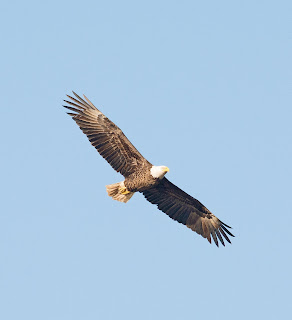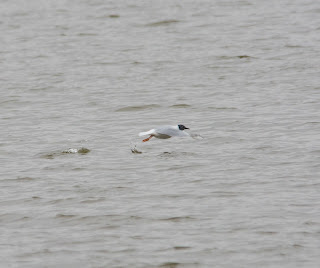Black-chinned Hummingbird
Ditto
White-crowned Sparrow
04-21-19
Inks Lakes SP, Burnet, TX
All the above were taken at Inks Lakes, which boats nine miles of hiking trails. However, in transit to the Upper Valley, Pecan Flats was much more doable for a shorter period of time. Since the sun was on high, you'll have to believe when I tell you that the Crested Caracara riding thermals is a very beautiful bird with white fingers, white head, and white tail. If you do a search on this site, you can actually find the bird of which I speak. Additionally, the juvenile is brown, the adult is black, and the facial skin coloration can change rapidly from blue to pink or red.
There were also Blue-gray Gnatcatchers, Northern Cardinals, Inca and Ground Doves, and many others. Though not able to get to the water, there were no doubt water- and shorebirds available.
Egyptian Goose and Goslings
Muscovy Duck with Ducklings
Turkey Vulture
04-22-19 Johnson Park in Marble Falls, TX
0720-0830, partly cloudy
This is a second visit to Marble Falls, a good stopping point in transit to the Upper Rio Grande Valley. The last time I was there, I took an award-winning photo of two Great Horned owlets in their nesting cavity. The same tree is still standing, but it was unoccupied on this date, though there were many changes and improvements to the park, including structures.
The Egyptian Geese and Muscovies are a new addition, along with many Black and Turkey Vultures.
It was impossible to resist the little ones, who enjoyed posing for photo ops.
Texas Blackbuck Antelope (Exotic)
Ditto (Note Colorful Male)
04-22-19
Harvey Lane at Gillespie County Line, Texas
These domestics were an interesting find that could not be passed.
Red Spotted Frog
04-23-19
The above red spotted frog was found at the first private ranch that was toured. It was not an active ranch, yet the owners have been working very hard to have native plants, trees, and grass to be enjoyed by the wildlife there. The ranch is five thousand acres with both breeding endangered Golden-cheeked Warblers and the recently delisted Black-capped Vireo. My first Golden-cheeked Warbler was viewed at this ranch, which is also bisected by the West Nueces River and has a cliff face with the first Canyon Wren that I have seen. This lovely property hosts the endangered Texas snowbell (native flower) and Tobusch fishhook cactus.
The family that owns the ranch personally toured us. They also manage white-tailed deer and also host both wild and exotic game.
I personally wish to thank the family who wish to remain nameless. They were wonderful hosts and very generous with both their time and welcoming nature. Kudos to you both, Mr. and Mrs. S, I will never forget your kindness and the time that you spent! You deserve an award for educating the public and helping the natural world proliferate.
Orange-crowned Warbler
Armadillo
Kickapoo Cavern SP
04-23-19
Wonderful hiking, birds, a LIVE armadillo, a nice bird blind with assorted sparrows, a Spotted Towhee, Orange-crowned Warbler, and several other birds primed us for even greater adventure.
Kickapoo Cavern also hosted Mexican freestyle bats after dinner, a Red-tailed Hawk eyeing the bats, and a wonderful talk about the million bats exiting the bat cave. The photo shoot wasn't as good as it could have been, but amazing things are held in my memory banks as a result of this after dinner fare.
We also observed countless birds prior to this treat, including the rarer Varied Bunting.












































